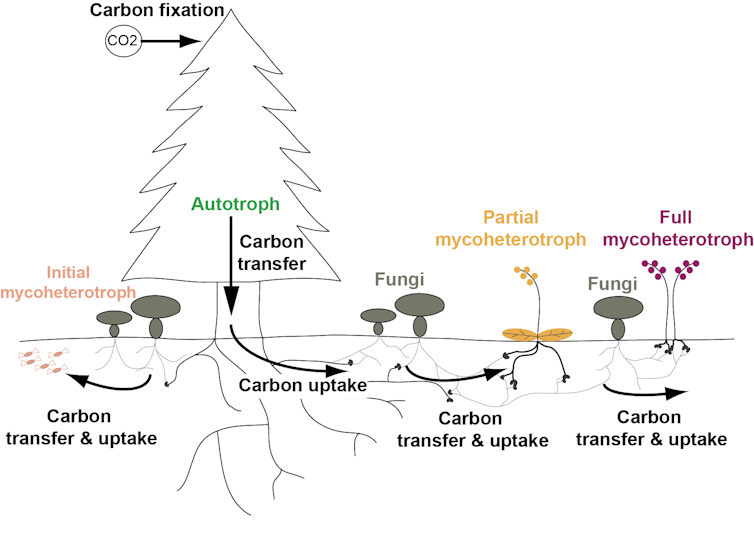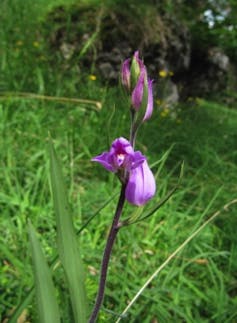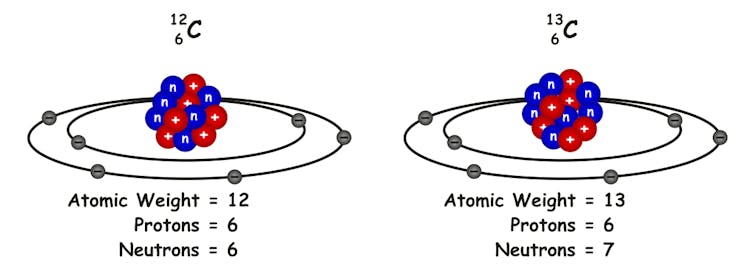Partial mycoheterotrophs: The green plants that feed on fungi
- Written by Nicole Hynson, Associate Professor of Botany, University of Hawaii
You probably learned this basic lesson of biology in elementary school: Plants are self-feeders. These so-called autotrophs[1] use the sun’s energy and water to turn carbon dioxide from the air into food through the process known as photosynthesis. Autotrophic organisms sit at the base of every food chain on Earth and sustain all levels of life as we know it.
But competition among plants for resources like water, light and nutrients can be intense. Unlike most living things, plants are basically immobile, stuck in the place where they’re rooted. They don’t have legs to escape unpleasant conditions. They can’t run after prey or head to the store when they’re hungry.
Because of this rootedness, plants have come up with some intriguing adaptations for making a living, one of which is known as “mycoheterotrophy” or “fungus-feeding.”[2]
The majority of land plant families form mutually beneficial partnerships with root-inhabiting fungi known as mycorrhizal fungi. But some plants have evolved to cheat this mutualism[3]. They don’t provide any known return benefits – such as carbohydrates derived from photosynthesis – to their fungal partners. Instead, these mycoheterotrophic plants receive both carbohydrates and other nutrients from their mycorrhizal partners, subverting the need to compete with neighboring plants for resources.
This selfish kind of symbiotic relationship between plants and fungi was a surprising revelation for botanists and adds some nuance to our basic understanding of how plants make a living.
 Mycoheterotrophic plants depend on fungi to meet some or all of their carbon needs. Sometimes they share a network of mycorrhizal fungi with surrounding trees.
Nicole Hynson, CC BY-ND[4]
Mycoheterotrophic plants depend on fungi to meet some or all of their carbon needs. Sometimes they share a network of mycorrhizal fungi with surrounding trees.
Nicole Hynson, CC BY-ND[4]
Siphoning off the good stuff
Often these mycoheterotrophic plants pair with fungi that they share with surrounding trees. What this means is that the original carbon source for many mycoheterotrophs is photosynthesis performed by a neighboring tree. These trees, being good partners, use some of the carbon they produce through photosynthesis to “pay” their mycorrhizal fungi. But some of this carbon is “stolen” by the mycoheterotroph. Clever.
This three-part network of autotroph, mycoheterotroph and mycorrhizal fungus may seem bizarre, but the mycoheterotrophic lifestyle has actually arisen at least 46 independent times[5] throughout the evolutionary history of the plant kingdom. It turns up in seven out of the 10 major lineages of land plants. The largest plant family on Earth – the orchids – are all initially mycoheterotrophic[6] at their earliest stages of seedling development.
 Cephalanthera rubra, a partially mycoheterotrophic orchid.
Nicole Hynson, CC BY-ND[7]
Cephalanthera rubra, a partially mycoheterotrophic orchid.
Nicole Hynson, CC BY-ND[7]
When it comes to mycoheterotrophy, orchids present a particularly interesting example due not only to their sheer diversity and wide global distributions[8], but because they are the bet hedgers of the plant kingdom. All wild orchids rely on fungi to feed developing seedlings. But once they mature to the point of forming leaves – thereby becoming capable of feeding themselves via photosynthesis – not all orchids give up the cushy sugar-daddy relationship[9] they have with fungi.
Instead, these orchids remain partially mycoheterotrophic, deriving a portion of their carbohydrates from their fungal symbionts while meeting the remainder of their demands through photosynthesis. Interestingly, this reliance on mycoheterotrophy can increase or decrease[10] in response to changing environmental conditions such as light availability.
Taking it down to the atomic level
These leafy green orchids look like any other autotrophic plant. So how do ecological researchers like me[11] know that they’re partially mycoheterotrophic? The answer lies in the atom.
Another basic lesson you may remember, this time from chemistry class, is that atoms are made up of three primary particles: electrons, protons and neutrons. An atom’s mass is determined by a count of its protons and neutrons.
For example, if you look at a periodic table of elements, carbon has an atomic number of six: it has six protons and, most commonly, six neutrons. This version of carbon – also known as ¹²C – is the most abundant form of carbon on Earth, making up 98.89 percent of the stable carbon on our planet.
 Based on how many neutrons they contain, carbon atoms come in different isotopic flavors.
udaix/Shutterstock.com[12]
Based on how many neutrons they contain, carbon atoms come in different isotopic flavors.
udaix/Shutterstock.com[12]
But it’s not the only form. Like most elements, carbon comes in rarer flavors, too. These forms, with different atomic masses due to varying numbers of neutrons, are called isotopes. A version of carbon known as ¹³C – thanks to its six protons and seven neutrons – makes up the other 1.1 percent of stable carbon on Earth.
What do isotopes have to do with detecting mycoheterotrophic orchids? Turns out, quite a lot because of the way living things – like plants – use or “digest” the different versions of carbon. Under ideal conditions, plants prefer to use the vastly more abundant ¹²CO₂ as an ingredient for photosynthesis, though they can use the heavier ¹³CO₂ version too.
Once CO₂ is fixed within the plant, whichever isotopes it contained, as the carbon is processed or “digested” the ratio of ¹³C to ¹²C changes. The plant’s tissues end up with relatively more ¹²C than what was in what they originally “ate.” When that plant uses some of its carbon originating from photosynthesis to feed its mycorrhizal fungi, the fungi receive specific carbon molecules that are enriched in ¹³C relative to the whole plant.
This an isotope food chain. As you go from primary producer, to consumer and so on, organisms become more and more enriched in the heavy form of carbon or ¹³C.
An autotroph’s atomic signature
Scientists can measure the ratio of ¹³C to ¹²C in plants, fungi or the air we breathe. Using a machine called a stable isotope mass spectrometer, we count the number of ¹³C versus ¹²C atoms in a substrate. But what does that ratio tell us? Based on the relative abundance of ¹³C atoms we can say where an organism falls within a food chain – that is, whether it’s an autotroph or a consumer.
We know that when a plant relies mainly on autotrophy it will have relatively few ¹³C atoms. But in the case of some orchids, their ¹³C counts are through the roof, with carbon ratios more similar to those of fungi than plants. This finding, published in 2003[13], was the first indication that these orchids were relying, at least in part, on a very different form of carbon[14] than their neighboring autotrophs.
Being rooted can lead to interesting and unexpected partnerships for plants – definitely more than meets the eye.
References
- ^ autotrophs (www.nationalgeographic.org)
- ^ “mycoheterotrophy” or “fungus-feeding.” (doi.org)
- ^ evolved to cheat this mutualism (doi.org)
- ^ CC BY-ND (creativecommons.org)
- ^ arisen at least 46 independent times (doi.org)
- ^ the orchids – are all initially mycoheterotrophic (doi.org)
- ^ CC BY-ND (creativecommons.org)
- ^ sheer diversity and wide global distributions (www.jstor.org)
- ^ not all orchids give up the cushy sugar-daddy relationship (doi.org)
- ^ reliance on mycoheterotrophy can increase or decrease (doi.org)
- ^ ecological researchers like me (scholar.google.com)
- ^ udaix/Shutterstock.com (www.shutterstock.com)
- ^ published in 2003 (doi.org)
- ^ very different form of carbon (doi.org)
Authors: Nicole Hynson, Associate Professor of Botany, University of Hawaii
Read more http://theconversation.com/partial-mycoheterotrophs-the-green-plants-that-feed-on-fungi-81643


